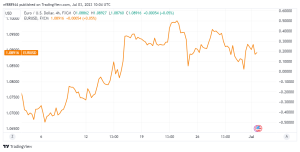Following Friday’s bounce, the EURUSD lost traction in the European morning and fell below 1.0900. The pair is still technically bearish, and more losses are possible if 1.0840 support fails.
Soft US Personal Consumption Expenditures (PCE) inflation data pushed. The US Dollar (USD) under further selling pressure. Ahead of the weekend, allowing EURUSD to recoup its weekly losses. The PCE Price Index fell to 3.8% in May, down from 4.3% in April. While the Core PCE Price Index fell to 4.6%, down from 4.7%.
However, market positioning implies that the PCE inflation statistics had little to no influence. On market pricing of the Federal Reserve’s (Fed) rate forecast. As a result, the USD’s negative move. On Friday may have been exaggerated by quarter-end flows.
Markets are virtually completely pricing in a 25-basis point (bps) Fed rate rise in July, with a 40% possibility of another rate hike before the end of the year, according to the CME Group Fed Watch Tool.
Markets in the United States will close early to observe the Fourth of July holiday.
The ISM Manufacturing PMI data will be included in the US economic docket in the second part of the day. Investors anticipate that the headline PMI will rise slightly to 47.2 in June from 46.9 in May. A rating above 50 might help the USD maintain its momentum in the second half of the day. It’s worth remembering that the US stock and bond markets will close early on July 4th in commemoration of the Independence Day holiday. As a result, with trading conditions thinning out in the American session, EURUSD may struggle to find direction.
EURUSD Technical Analysis
EURUSD was trading just below 1.0900, where the four-hour chart’s 100- and 20-period Simple Moving Averages (SMA) overlap. If the pair fails to stabilize above that level, 1.0870 (Fibonacci 38.2% retracement of the most recent upswing) serves as the first support level before 1.0840 (Fibonacci 50% retracement).

A four-hour closing below the latter might attract more selling and pave the way for a longer-term decline around 1.0810/1.0800 (200-period SMA, Fibonacci 61.8% retracement).
If the EURUSD confirms, 1.0930 (Fibonacci 23.6% retracement, 50-period SMA) is the next obstacle before 1.0960 (static level).









